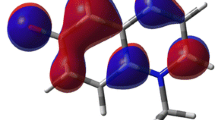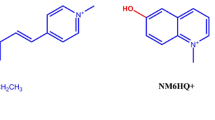Abstract
(Time-dependent) Kohn-Sham density functional theory and a combined density functional/multi-reference configuration interaction method (DFT/ MRCI) were employed to explore the ground and low-lying electronically excited states of alloxazine, a flavin related molecule. Spin-orbit coupling was taken into account using an efficient, nonempirical mean-field Hamiltonian. Intersystem crossing (ISC) rate constants for S→T transitions were computed, employing both direct and vibronic spin-orbit coupling. Solvent effects were mimicked by a conductor-like screening model and micro-hydration with up to six explicit water molecules. Multiple minima were found on the first excited singlet (S1) potential energy hypersurface (PEH) with electronic structures 1(nπ*) and1(ππ*), corresponding to the dark 1 1A″ (S1) state and the nearly degenerate, optically bright 2 1A′ (S2) state in the vertical absorption spectrum, respectively. In the vacuum the minimum of the 1(nπ*) electronic structure is clearly found below that of the 1(ππ*) electronic structure. Population transfer from 1(ππ*) to 1(nπ*) may proceed along an almost barrierless pathway. Hence, in the vacuum, internal conversion (IC) between the 2 1A′ and the 1 1A″ state is expected to be ultrafast and fluorescence should be quenched completely. The depletion of the 1(nπ*) state is anticipated to occur via competing IC and direct ISC processes. In aqueous solution this changes, due to the blue shift of the 1(nπ*) state and the red shift of the 1(ππ*) state. However, the minimum of the 1(nπ*) state still is expected to be found on the S1 PEH. For vibrationally relaxed alloxazines pronounced fluorescence and ISC by a vibronic spin-orbit coupling mechanism is expected. At elevated temperatures or excess energy of the excitation laser, the 1(nπ*) state is anticipated to participate in the deactivation process and to partially quench the fluorescence.
Similar content being viewed by others
References
J. Koziol, Absorption spectra of riboflavin, lumiflavin, and lumichrome in organic solvents, Cell. Mol. Life Sci., 1965, 21, 189–190.
J. Koziol, Studies on Flavins in organic solvents-I*. Spectral characteristics of riboflavin, riboflavin tetrabutyrate and lumichrome, Photochem. Photobiol., 1966, 5, 41–54.
J. Koziol, Fluorometric analyses of riboflavin and its coenzymes, Methods Enzymol., 1971, 18, 253–285.
P.-S. Song, M. Sun, A. Koziolowa, J. Koziol, Spectroscopic characterization of poly(alanylglycylglycine), J. Am. Chem. Soc., 1974, 96, 4319–4323.
R. D. Fugate, P.-S. Song, Lifetime study of phototautomerism of alloxazine and lumichromes, Photochem. Photobiol., 1976, 24, 479–481.
J. D. Choi, R. D. Fugate, P.-S. Song, Nanosecond time-resolved fluorescence of phototautomeric lumichrome, J. Am. Chem. Soc., 1980, 102, 5293–5297.
E. Sikorska, I. Khmelinskii, M. Hoffmann, I. F. Machado, L. F. V. Ferreira, K. Dobek, J. Karolczak, A. Krawczyk, M. Insinska-Rak, M. Sikorska, Ground- and excited-state double proton transfer in lumichrome/acetic acid system: Theoretical and experimental approach, J. Phys. Chem. A, 2005, 109, 11707–11714.
E. Sikorska, H. Szymusiak, A. Koziolowa, J. Spanget-Larsen, M. Sikorski, Spectroscopy and photophysics of alloxazines studied in their ground and first excited singlet states, J. Photochem. Photobiol., A, 2003, 158, 45–53.
P. F. Heelis, The photophysical and photochemical properties of flavins (isoalloxazines), Chem. Soc. Rev., 1982, 11, 15–39.
V. Massey, The chemical and biological versatility of riboflavin, Biochem. Soc. Trans., 2000, 28, 283–296.
A. Losi, Flavin-based blue-light photosensors: A photobiophysics update, Photochem. Photobiol., 2007, 83, 1283–1300.
M. Sikorski, D. Prukala, M. Insinska-Rak, I. Khmelinskii, D. R. Worrall, S. L. Williams, J. Hernando, J. L. Bourdelande, J. Koputa, E. Sikorska, Spectroscopy and photophysics of dimethyl-substituted alloxazines, J. Photochem. Photobiol., A, 2008, 200, 148–160.
E. Sikorska, I. V. Khmelinskii, W. Prukala, S. L. Williams, M. Patel, D. R. Worrall, J. L. Bourdelande, J. Koput, M. Sikorski, Spectroscopy and photophysics of lumiflavins and lumichromes, J. Phys. Chem. A, 2004, 108, 1501–1508.
E. Sikorska, I. V. Khemlinskii, D. R. Worrall, S. L. Williams, R. Gonzalez-Moreno, J. L. Bourdelande, J. Koput, M. Sikorski, Photophysics of 1-methyllumichrome, J. Photochem. Photobiol., A, 2004, 162, 193–201.
M. Sikorski, E. Sikorski, A. Koziolowa, R. G. Moreneo, J. L. Bourdelande, R. P. Steer, F. Wilkinson, Photophysical properties of lumichromes in water, J. Photochem. Photobiol., B, 2001, 60, 114–119.
M. S. Grodowski, B. Veyret, K. Weiss, Photochemistry of flavins. II. Photophysical properties of alloxazines and isoalloxazines, Photochem. Photobiol., 1977, 26, 341–352.
E. Sikorska, I. V. Khmelinskii, D. R. Worrall, J. Koput, M. Sikorski, Spectroscopy and photophysics of iso- and alloxazines: Experimental and theoretical study, J. Fluoresc., 2004, 14, 57–64.
J. Komasa, J. Rychlewski, J. Koziol, Electronic structure of alloxazine and its methyl derivatives, THEOCHEM, 1988, 170, 205–212.
H. Szymusiak, J. Komarski, J. Koziol, An INDO/S MO study of alloxazine and its monomethyl derivatives, J. Chem. Soc., Perkin Trans. 2, 1990, 229–236.
M. Sung, T. A. Moore, P.-S. Song, Molecular luminescence studies of flavines. I. Excited states of flavins, J. Am. Chem. Soc., 1972, 94, 1730–1740.
T. Climent, R. González, M. Merchán, L. Serrano-Andrés, Theoretical insight into the spectroscopy and photochemistry of isoalloxazine, the flavin core ring, J. Phys. Chem. A, 2006, 110, 13584–13590.
J. Hasegawa, S. Bureekaew, H. Nakatsuji, SAC-CI theoretical study on the excited states of lumiflavin: Structure, excitation spectrum, and solvation effect, J. Photochem. Photobiol., A, 2007, 189, 205–210.
E. Sikorska, I. V. Khmelinskii, J. Koput, J. L. Bourdelande, M. Sikorski, Electronic structure of isoalloxazines in their ground and excited states, J. Mol. Struct., 2004, 697, 137–141.
C. Neiss, P. Saalfrank, M. Parac, S. Grimme, Quantum chemical calculation of excited states of flavin-related molecules, J. Phys. Chem. A, 2003, 107, 140–147.
K. Zenichowski, M. Gothe, P. Saalfrank, Exciting flavins: Absorption spectra and spin-orbit coupling in light-oxygen-voltage (LOV) domains, J. Photochem. Photobiol., A, 2007, 190, 290–300.
S. Salzmann, J. Tatchen, C. M. Marian, The photophysics of flavins: What makes the difference between gas phase and aqueous solution?, J. Photochem. Photobiol., A, 2008, 198, 221–231.
S. Salzmann, V. Martinez-Junza, B. Zorn, S. E. Braslavsky, M. Mansurova, C. M. Marian, W. Gärtner, Photophysical properties of structurally and electronically modified flavin derivatives determined by spectroscopy and theoretical calculations, J. Phys. Chem. A, 2009, 113, 9365–9375.
J. Götze, P. Saalfrank, Serine in BLUF domains displays spectral importance in computational models, J. Photochem. Photobiol., B, 2009, 94, 87–95.
A. Weigel, A. L. Dobryakov, M. Veiga, J. L. P. Lustres, Photoinduced Processes in Riboflavin: Superposition of ππ*-nπ* states by vibronic coupling, transfer of vibrational coherence, and population dynamics under solvent control, J. Phys. Chem. A, 2008, 112, 12054–12065.
R. Ahlrichs, M. Bär, H.-P. Baron, R. Bauernschmitt, S. Böcker, N. Crawford, P. Deglmann, M. Ehrig, K. Eichkorn, S. Elliott, F. Furche, F. Haase, M. Häser, C. Hättig, H. Horn, C. Huber, U. Huniar, M. Kattannek, A. Köhn, C. Kölmel, M. Kollwitz, K. May, P. Nava, C. Ochsenfeld, H. Öhm, H. Patzelt, D. Rappoport, O. Rubner, A. Schäfer, U. Schneider, M. Sierka, O. Treutler, B. Unterreiner, M. von Arnim, F. Weigend, P. Weis and H. Weiss, TURBOMOLE (Vers. 5.10), Universität Karlsruhe, Karlsruhe, Germany, 2008.
C. Kind, M. Reiher and J. Neugebauer, SNF Version 2.2.1: A Program Package for Numerical Frequency Analyses, Universität Erlangen, Erlangen, Germany, 1999-2002.
A. P. Scott, L. Radom, Harmonic Vibrational Frequencies: An evaluation of Hartree-Fock, Møller-Plesset, Quadratic Configuration Interaction, Density Functional Theory, and Semiempirical Scale Factors, J. Phys. Chem., 1996, 100, 16502–16513.
S. Grimme, M. Waletzke, A combination of Kohn-Sham density functional theory and multi-reference configuration interaction methods, J. Chem. Phys., 1999, 111, 5645–5655.
J. Tatchen, VIBES, Universität Düsseldorf, Düsseldorf, Germany, 2005.
M. Dierksen, PLOTTER Verison 0.3, Westfälische Wilhelms-Universität Münster, Münster, Germany, 2002.
M. Kleinschmidt, J. Tatchen, C. M. Marian, Spin-orbit coupling of DFT/MRCI wavefunctions: Method, test calculations, and application to thiophene, J. Comput. Chem., 2002, 23, 824–833.
M. Kleinschmidt, C. M. Marian, Efficient generation of matrix elements for one-electron spin-orbit operators, Chem. Phys., 2005, 311, 71–79.
B. A. Hess, C. M. Marian, U. Wahlgren, O. Gropen, A mean-field spin-orbit method applicable to correlated wavefunctions, Chem. Phys. Lett., 1996, 251, 365–371.
B. Schimmelpfennig, AMFI, Stockholm University, Stockholm, Sweden, 1996.
M. A. El-Sayed, The radiationless processes involving change of multiplicity in the diazenes, J. Chem. Phys., 1962, 36, 573–574.
J. Tatchen, N. Gilka, C. M. Marian, Intersystem crossing driven by vibronic spin-orbit coupling: A case study on psoralen, Phys. Chem. Chem. Phys., 2007, 9, 5209–5221.
S. Perun, J. Tatchen, C. M. Marian, Singlet and triplet excited states and intersystem crossing in free-base porphyrin: TDDFT and DFT/MRCI study, ChemPhysChem, 2008, 9, 282–292.
A. Klamt, G. Schüürmann, COSMO: A new approach to dielectric screening in solvents with explicit expressions for the screening energy and its gradient, J. Chem. Soc., Perkin Trans. 2, 1993, 799–805.
A. Schäfer, A. Klamt, D. Sattel, J. Lohrenz, F. Eckert, COSMO Implementation in TURBOMOLE: Extension of an efficient quantum chemical code towards liquid systems, Phys. Chem. Chem. Phys., 2000, 2, 2187–2193.
C. Reichardt, Solvent effects in organic chemistry, VCH, Weinheim, 1990.
K. Tomic, J. Tatchen, C. M. Marian, Quantum chemical investigation of the electronic spectra of the keto, enol, and keto-imine tautomers of cytosine, J. Phys. Chem. A, 2005, 109 37, 8410–8418.
S. Salzmann, M. Kleinschmidt, J. Tatchen, R. Weinkauf, C. M. Marian, Excited states of thiophene: Ring opening as deactivation mechanism, Phys. Chem. Chem. Phys., 2008, 10, 380.
N. Gavrilov, S. Salzmann, C. M. Marian, Deactivationvia ring opening: A quantum chemical study of the excited states of furan and comparison to thiophene, Chem. Phys., 2008, 349, 269–277.
R. H. Dekker, B. N. Srinivasan, J. R. Huber, K. Weiss, Photochemistry of flavins-I. Conventional and laser flash photolysis study of alloxazine, Photochem. Photobiol., 1973, 18, 457–466.
M. Sikorski, E. Sikorska, D. R. Worrall, F. Wilkinson, Efficiency of singlet oxygen generation by alloxazines and isoalloxazines, J. Chem. Soc., Faraday Trans., 1998, 94, 2347–2353.
Y. J. Bomble, K. W. Sattelmeyer, J. F. Stanton, J. Gauss, On the vertical excitation energy of cyclopentadiene, J. Chem. Phys., 2004, 121, 5236–5240.
E. R. Davidson, A. A. Jarzecki, Zero point corrections to vertical excitation energies, Chem. Phys. Lett., 1998, 285, 155–159.
L. S. Cederbaum, W. Domcke, A many-body approach to the vibrational structure in molecular electronic spectra. I. Theory, J. Chem. Phys., 1976, 64, 603–611.
Author information
Authors and Affiliations
Additional information
Electronic supplementary information (ESI) available: Experimental data, optimized geometries of alloxazine water complexes, calculation of the intersystem crossing rate constants. See DOI: 10.1039/b9pp00022d
Rights and permissions
About this article
Cite this article
Salzmann, S., Marian, C.M. The photophysics of alloxazine: a quantum chemical investigation in vacuum and solution. Photochem Photobiol Sci 8, 1655–1666 (2009). https://doi.org/10.1039/b9pp00022d
Received:
Accepted:
Published:
Issue Date:
DOI: https://doi.org/10.1039/b9pp00022d




